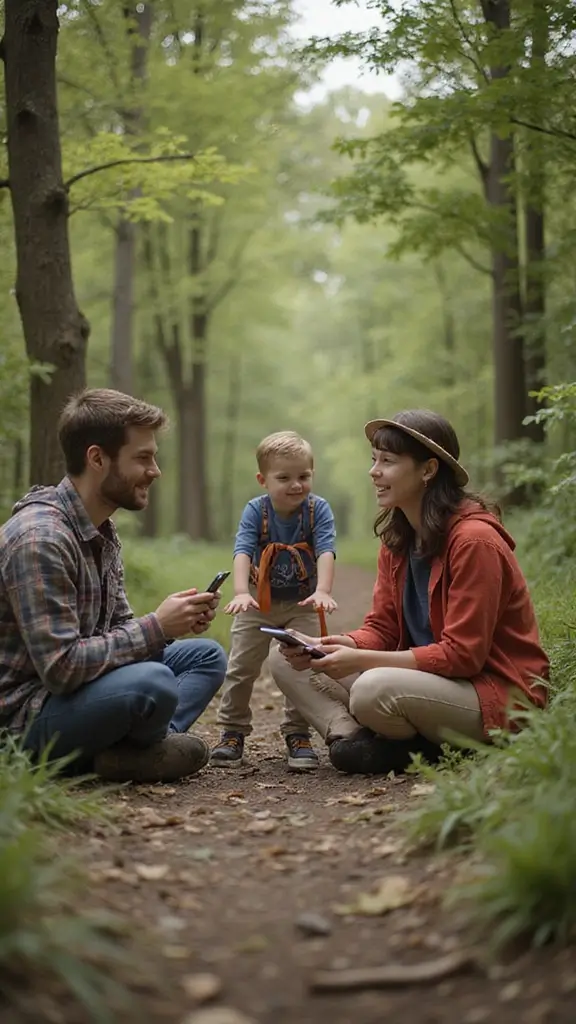I made this post because I see families trying to stay close in a fast world where screens pull attention and schedules fill up. Familia del 20 started as an idea from conversations with neighbors who want a stronger sense of home despite busy days. I want to offer something real—practical tips that help a family feel connected without adding more stress.
If you’re a parent who wants calmer evenings, a grandparent who loves being part of daily life, or a blended family building one home, this is for you. You care about simple traditions, honest talk, and moments that bring you back to one table. You want ideas that fit real life, not grand plans that never start.
1. Embrace Digital Tools Together

If you want stronger family bonds in a busy home, use digital tools with intention.
Tech can lift your together time when you steer it on purpose.
Try activities that mix fun with learning.
You can do them as a team, not a solo hobby.
Smart ways to bond through screens
– Create shared playlists that include everyone’s favorite songs and moments.
– Take virtual museum tours together and talk about what you see.
– Play online cooperative games that need teamwork and planning.
– Set up a family calendar in a shared app so everyone adds important dates.
– Plan regular tech-free blocks for walks, cooking, or board games.
– Have open discussions about online life, what you learn, and how you feel.
– Use these ideas to start small and build over time.
Boundaries help you stay friendly with tech.
Set healthy screen-time limits that fit your routine.
Talk about online experiences as a family, and adjust rules as needed.
Together, you build trust and safer online habits.
These tools are helpers, not a fix. Start with one activity, then add more as you feel comfortable.
If a tool ruins the moment, turn it off and switch to a simple offline moment.
Keep your family values in mind as you grow together online.
Product Recommendations:
• Yahtzee Game
• Amazon Echo Pop
• Skylight Calendar
2. Establish Family Traditions

You want stronger family ties. Traditions give your family a steady rhythm and a place where everyone belongs. They turn busy days into memories you can hold in your heart.
– Start small with a simple tradition like Sunday brunch or a winter picnic. This gives you an easy entry point and a pattern your family can look forward to.
– Invite everyone to share ideas so each member feels included. When people see their plans become part of the routine, they stay engaged.
– Pick a regular rhythm. A monthly dinner, a yearly weekend trip, or a seasonal activity keeps momentum without burning you out. Mark it on the calendar and set gentle reminders.
– Make it tangible. Take photos, keep a simple scrapbook, or make a shared playlist. Small keepsakes help you revisit the moment later.
– Use the moments at gatherings. Bring the tradition into meals or games and let everyone reflect on what it means.
– Embrace your family’s quirks. Traditions fit your values and tastes and should feel authentic, not forced.
– Remember the payoff. Traditions bring stability and a deeper sense of connection that lasts through busy weeks.
This approach answers common questions: How do we start with little effort? Which traditions fit our family’s schedule? How do we keep traditions alive when life gets hectic? The key is consistency, flexibility, and joy in shared time. You can start this weekend.Product Recommendations:
• Vienrose DIY Scrapbook Photo Album Kit
• Taco Cat Goat Cheese Pizza Card Game
• FAMILY NAME CALENDAR Personalized Acrylic Wall Calendar
3. Foster Independence

Key steps to foster independence
You want your kids to grow confident, responsible, and still feel close to your family. Fostering independence helps them stand on their own while you guide them with care.
Start with simple chores that fit their age, like cooking a basic meal or packing their backpack. These tasks build pride, sharpen focus, and give your child a small but real sense of belonging.
Let them choose a family activity, then talk about everyone’s likes and limits before you go. This practice teaches compromise and respect, while you model how to listen and share opinions. Celebrate small wins with a thumbs up, a quick cheer, or a note tucked in their lunch.
But guide decisions first, discuss possible outcomes, and help them weigh risks before they act. If a choice backfires, talk about what happened, what to do differently, and how to fix it. Independence grows when your guidance is steady, clear, and not overbearing.
Set a routine that includes responsible tasks, then slowly add challenges as your child proves ready. Overall, independence should deepen connection, not loosen it, so keep conversations, check-ins, and shared meals alive. If you want more, try one month of rotating chores and a family goal board.
Product Recommendations:
• Magnetic Dry Erase Chore Chart
• Pretzel Making Kit – Real Cooking Set for Kids
• Magnetic Whiteboard for Fridge – Large Dry Erase Calendar
4. Digital Detox Retreats

In a world flooded with screens, your family can miss real talk and easy smiles. A digital detox weekend gives you those moments back. You unplug, you talk, you remember how simple fun can be.
Plan a weekend unplugged
– Pick a simple spot: park, campground, cabin, or yard.
– Set simple rules: no devices at meals, no screens in shared spaces.
– Choose outdoor and low-tech activities: nature walks, scavenger hunt, board games, storytelling circle.
– Add a small ritual to end each day: campfire, star gaze, quiet talk.
Starting small helps
– If a weekend feels long, start with a single unplugged day.
– You’ll notice calmer mornings and easier chats.
– That small start can grow into a regular family ritual.
Document memories without screens
– Use a paper journal or scrapbook.
– Share photos later and talk about the weekend.
Benefits and how it sticks
– You talk more, listen better, and laugh together.
– Sleep improves when phones stay away at night.
– Turn this into a habit so everyone looks forward to disconnecting.
Common bumps and quick fixes
– Bad weather? switch to inside games and stories.
– Shy kids? give them a small role, like lead storyteller.
– Costs? borrow games, keep meals simple, and use free trails.
Getting started
– Choose a date and place.
– Tell your family what to expect.
– Pack light: water, snacks, blankets, a first-aid kit, simple games, and a journal.
Product Recommendations:
• Giant SORRY! Classic Family Board Game
• YagCu Scrapbook Kit for Beginners
• First Aid Only OSHA-Compliant First Aid Kit
5. Celebrate Achievements Together

You want a family that feels seen and encouraged. Celebrating wins, big or small, builds positivity and teamwork. Here is a simple, doable plan you can start this month. These small moments matter more than you think.
– Keep a celebration jar.
Each time someone hits a goal, write it on a slip and drop it in the jar. Read a few notes together at the end of the month. Keep the jar in a common place where everyone can see it.
– Set a monthly celebration day.
Choose a day each month to share stories of wins. Pair it with setting a small goal for the next month. Let kids take turns choosing the moment to highlight.
– Personalize celebrations.
Make celebrations fit your family vibe. Bake a cake for a milestone, or host a mini awards ceremony at home. Ask each person what kind of treat or trophy would make them smile.
– The impact of recognition.
Recognition boosts self-esteem and emotional well-being. It also strengthens family bonds. Regular praise builds trust and a sense of teamwork.
Keep it simple and consistent. Over time, these celebrations weave a strong, positive rhythm for your family. If a month feels hard, start with one practice this week.
Product Recommendations:
• WHJY 5oz Glass Jars with Cork Lids
• Crown Awards Gold Cup Trophies with Custom Engraving
• Wooden Cooking & Baking Set for Kids
6. Practice Gratitude as a Family

If you want stronger family bonds, start today with simple gratitude practices you can stick to. Small, steady habits beat big promises.
– Gratitude jar Put a jar on the kitchen counter. Each week, someone writes a short note about what they are thankful for. The notes go into the jar with a soft rustle. At month’s end, read a few aloud and name the moments you care about. You can keep the jar inviting so everyone wants to drop in a note.
– Verbal thanks at meals During dinner, ask everyone to share one thing they appreciated that day. It could be a kind word, a tasty bite, or a small win. This practice slows the rush and makes meals feel like a circle. Listen closely to each speaker and respond with kind, specific words.
– Family gratitude journal Use one notebook or a shared digital note. Each person adds a line or two about what moved them. You can add dates, doodles, or tiny photos. Review a few entries together each week to see changes in mood and care. If someone is shy, they can write instead of speaking.
– Acts of kindness together Choose a small project you can do as a team—help a neighbor, donate clothes, or volunteer once a month. Even 15 minutes counts. Rotating who picks the project keeps everyone involved and builds a shared sense of purpose.
Keep it simple: set a quick reminder, keep notes short, and schedule a monthly check-in to celebrate progress. With time, gratitude becomes a natural part of your family routine.
Product Recommendations:
• Clabby Gratitude Jar Thanksgiving Gifts
• Family Gratitude Journal: 52 prompts to add happiness to your home
• Crochet & Kindness: Project Ideas logbook & Crochet Journal
7. Incorporate Mindfulness Practices

Busy days pull your family in many directions. You want to feel calmer, listen better, and grow closer. They are easy to fit into meals, drive times, or after school.
Mindfulness practices help you do that without extra gear or big changes.
Try these simple practices you can fit into ordinary days:
– Focused breathing — Sit together for one minute and breathe in for four counts, hold two, exhale six.
– Mindful walks — Take a short stroll and notice sounds, colors, textures, and how your body feels.
– Phone-free moments — Put devices away during the activity so you can truly listen and connect.
– Feelings sharing — Afterward, invite each person to name one mood or thought in their own words.
– Keep it simple — Do these practices at a regular time, even on busy days, to build a steady routine.
These simple practices boost emotional well-being by helping kids name feelings, calm emotions, and listen better.
A steady routine means you can turn small moments into real connection.
Start today, even if you feel busy. It gets easier as the routine becomes normal.
Product Recommendations:
• Mindfulness for Kids in 10 Minutes a Day: Simple Exercises to Feel Calm…
• Sorry! Kids Board Game
• Family Board Games for Kids and Adults
• 2 to 4 P…
• Worry for Nothing: Guided Anxiety Journal
• Cognitive Behavioral Therapy …
8. Strengthen Connections with Technology Skills

You want your family to grow closer, not drift apart when screens glow. Teaching tech lets you learn together and feel a real sense of teamwork.
– Choose age-appropriate platforms that feel fun. Try Scratch for kids who want to code, Canva for simple graphic design, or beginner video editors like iMovie or Clipchamp. Pick one project you can finish in a week.
– Create friendly challenges. Each week, someone picks a small project, and everyone presents their work at a family night. This builds skill and confidence.
– Offer calm help during tough moments. Break tasks into tiny steps, celebrate small wins, and explain steps in plain words.
– Learn together with online resources. Watch short tutorials, try a guided course, and ask questions as a team. You can even co-create a family website or blog that shows your projects.
– Make it a shared home project. Set up a simple tech corner, assign roles, and schedule a regular show-and-tell night.
You’ll gain patience, better teamwork, and clearer communication. These projects show learning as a friendly adventure, not a chore. With steady effort, digital skills become tools your family relies on for years to come.
Product Recommendations:
• The Official Scratch Coding Cards (Scratch 3.0)
• Canva for Teachers: A Beginner’s guide to designing beautiful class materials
• The Basic & Optimize Adobe Premiere Pro Updated 2024 Guide for Beginners
9. Nurture Emotional Intelligence

Start quick, practical steps.
You want a family that talks about feelings. You want bonds that stay strong when stress shows up. Nurturing emotional intelligence helps you get there. It makes kids clearer about their emotions and keeps fights from getting big.
– Name the feeling in the moment. When a child drops a plate or snaps at a sibling, say, “I hear anger in your voice.” The goal is to label, not punish.
– Use daily checks. After meals or chores, ask, “What feeling stuck with you today?” Listen more than you speak.
– Build an emotion word wall. Put colors with words: blue for sad, red for angry, yellow for excited. Point to it during talks.
– Role-play simple scenes. Pretend a friend forgot to share. Then switch roles and practice calm words.
– Tell stories and discuss choices. Talk about characters’ feelings and what could help them feel better.
– Encourage sharing. Invite family members to describe a tough moment and what helped.
– Read and watch together. Pick books or videos that explore resilience and feelings. Discuss what you notice.
– Practice I-statements. Say, “I feel ___ when ___,” and explain what you need.
With regular practice, your family will name emotions more easily, solve small conflicts, and stay close.
Product Recommendations:
• Tatuo Feelings Wheel Poster
• My Body Sends a Signal: Helping Kids Recognize Emotions and Express Feelings
• Emotion Cards for Kids Social Skills
10. Connect Through Creative Projects

You want stronger family bonds but you don’t have time for big projects. Creative projects give you a simple, fun way to connect. When you work together, talk shifts from small talk to shared plans and laughter.
Why this matters
Creative projects teach teamwork and patience. A finished piece reminds you of the time you spent together.
Simple, doable ideas for your family
– Family mural on a wall or canvas with washable paints; everyone adds a piece.
– Craft night: make cards, cushions, or small sculptures from paper, fabric, or clay.
– Garden project: plant herbs or flowers and keep a simple garden journal.
– Seasonal crafts: create holiday decor like a wreath, collage, or winter scene.
– Collective art piece: combine drawings, photos, and collage into one frame.
Getting started
Getting started is easy.
– Gather basics: paper, glue, markers, scissors, paints, and any special materials you want.
– Set a time: 60 minutes works for most families.
– Divide roles: designer, builder, storyteller, and fixer help everyone stay involved.
– Share and display: hang the finished piece where everyone can see it daily.
– Reflect together: ask what you liked, what was funny, and what you learned.
If you want more, look for local community art fairs or school exhibitions to showcase your family’s work.
Product Recommendations:
• Crayola Washable Kids Paint (6ct)
• Arts & Crafts Supplies Kits & Materials Set for Kids
• Burpee SuperSeed Seed Starting Tray
11. Encourage Team Sports or Activities

Want stronger family bonds and more everyday joy? Encouraging team sports or group activities can help your family grow closer. When you play together, you learn to trust each other, stay steady, and share pride in small wins. You also build a routine that makes family time feel special.
Start with one activity that feels doable for everyone. Ask each member what they like and find a simple compromise. Put a friendly schedule on the fridge, like a Saturday afternoon event, so it becomes a habit. Keep sessions short and fun to avoid burnout.
Try a mix of easy, active choices:
– Soccer in the park gives quick teamwork practice.
– A short family hike builds endurance and calm time together.
– A dance class adds music, rhythm, and shared smiles.
– A charity walk shows you can help others as a team.
– Board game nights teach patience and good sportsmanship.
Keep it inclusive and flexible. Let young kids lead a stretch, and adults cheer from the side. Emphasize effort, not just wins. Clap for a good pass, a brave attempt, or a steady pace. If someone feels left out, pause and switch activities or swap partners.
Practical tips:
– Set a small, clear goal each month.
– Track progress on a simple family board or chat.
– Celebrate tiny wins with a high five or a note.
– Put safety first: proper shoes, warm-up, and water.
– Keep the pace light and fun, even on tough days.
Common questions:
– How do we include shy members? Let them pick a comfortable role and start with a simple activity.
– How long should we play? Start with 20–30 minutes, then grow as interest rises.
– What if we disagree on activities? Quick vote and rotate choices to keep things fair.
Product Recommendations:
• Yahtzee Game
• Sports Equipment Garage Organizer
• Maelstrom Hiking Backpack
12. Explore Cultural Heritage Together

Looking to feel closer to your relatives? Exploring your cultural heritage together can do that. It gives you a way to share stories, traditions, and the values that shape your family. It is simple to start and fits a busy life.
What to try first
– Monthly heritage night – Plan one evening a month where everyone wears a simple cultural item, shares a folktale, and learns a short traditional dance. This helps keep stories alive and builds shared memories.
– Capture family memories – Ask a grandparent for a memory, write it down, and tuck it in a memory box with photos. Reading them later makes younger members feel connected to elders.
– Explore music and food traditions – Play songs from your roots and sing along. Try a simple dish and talk about the memories it brings.
– Visit cultural spots – Plan trips to a festival, museum, or market that reflects your roots. Discuss what you see and what it means to your family.
– Preserve and pass on values – Use your heritage to talk about kindness, work, and family roles. Create a small project, like a family flag or a guide of traditions.
Getting started – Pick one idea this week and try it at a meal or a weekend gathering. Chat with a grandparent to gather a story. Keep it light, fun, and real.
Product Recommendations:
• History Activity Kit ‘Phoenicia Unboxed’
• Larger Wooden Memory Keepsake Boxes
• Tasteful and Healthy German Traditional Recipes Cookbook
13. Volunteer Together

Getting started with family volunteering
Your family wants stronger bonds and a chance to give back. Volunteering together can deliver both. It is helping others as a team, and it feels good.
To start, find local charities or community events that fit what your family cares about. Look for family volunteering ideas in your town or school notices. Check food banks, park cleanups, shelters, or animal rescues.
Let each person pick one option and set a day. This gives everyone ownership and keeps volunteering fair. Plan a simple activity so you stay focused.
Talking before and after the work
Before you go, talk about what you want to learn. After you serve, discuss the impact and the stories you heard. Ask each member to share one moment that stood out.
Volunteering builds character and gratitude. It strengthens teamwork and shows how your small acts add up. It also grows empathy and a better view of different lives and places.
Celebrate your effort as a family. A meal together, a short outing, or a movie night seals the memory. These times reinforce that you did good work as a team.
Volunteering together is a powerful way to grow as a family and help your community. It’s a shared experience you can repeat with new projects and fresh energy.
Product Recommendations:
• The Kid’s Guide to Service Projects: Over 500 Service Ideas for Young People
• Lead
• and Participate in Family Volunteer Projects
• The Family Table: Recipes and Moments from a Nomadic Family’s Journey
14. Utilize Family Apps for Connection

You want to stay close to your family even when life gets busy. The right family apps keep you in touch with less stress. They help with chores, plans, and sharing moments. With simple tools, everyone feels seen and involved.
Getting started with family apps
1) Choose family-friendly apps that fit your home and value system, so everyone can use them.
2) Set up a shared calendar and to-do lists so plans and chores appear for all.
3) Use a group chat for quick check-ins and last-minute plans, keeping messages short.
4) Schedule a weekly game or project session inside the apps to build a friendly routine, choose a fixed day, and remind everyone a bit beforehand.
5) Keep a living photo gallery or scrapbook so memories stay fresh and easy to revisit during busy times.
6) Establish simple tech rules to protect sleep, focus, and family time.
7) Review privacy settings and teach kids how to use apps safely.
Small steps here pay off later. The payoff shows in calmer mornings, smoother planning, and more smiles at dinner.
Start small this week. Pick two apps, add a few tasks, and set a regular family check-in together.
Product Recommendations:
• Skylight Calendar: 15-inch Wall Planner Digital Calendar & Chore Chart
• 32GB FRAMEO 10.1 Inch Smart WiFi Digital Photo Frame
• Sorry! Kids Board Game
• Family Board Games for Kids and Adults
15. Reflect and Share Experiences

You begin by setting a quick, calm moment after a family outing to talk. You keep it short and friendly.
– After each trip, set aside 10 to 15 minutes for sharing.
– Ask simple prompts: what did you enjoy most, and what did you learn.
– Create a family scrapbook where everyone adds a drawing, photo, or short note about the moment.
– The scrapbook becomes a living record you can flip through to see how you all grew.
– Share stories from tough moments.
– Talk about the lessons that helped you stay strong.
– Gather basic supplies: a notebook, markers, glue, and a few photos.
– Pick a monthly theme like “favorite memory” or “one thing I learned,” to guide entries.
– Rotate who leads the reflection so every voice gets a turn.
– For younger kids, use drawings or picture prompts to invite sharing.
– The routine builds trust.
– Keep the mood positive; end with a small thanks to someone for something they did.
– Store the scraps in a binder and consider a digital folder you can share with relatives.
– Make this a regular practice, not a one-time event.
– Over time, you will notice closer bonds and calmer days.
Product Recommendations:
• Echo Park Paper I Love Family Collection Kit
• Crayola Ultra Clean Washable Markers for School (40ct)
• Avery Write & Erase Dividers for 3 Ring Binders
• 8 Tabs per Set
Conclusion
Building strong family bonds in the modern age requires intentional effort and creativity. By embracing these Familia Del 20 strategies, you can cultivate an environment of love, support, and understanding.
Remember, the goal is to create lasting memories that strengthen connections and foster a sense of belonging. Start implementing these strategies today, and watch as your family relationships flourish!
Frequently Asked Questions
What Are Some Effective Ways to Prioritize Family Time in a Busy Schedule?
In today’s fast-paced world, it can be challenging to find time for your loved ones. One great strategy is to set a regular family date each week where everyone can come together without distractions. This could be a game night, movie night, or even a simple dinner where everyone shares their day. These small, dedicated moments can significantly strengthen your conexión familiar!
How Can I Improve Communication Within My Family?
Improving family communication starts with daily check-ins. Set aside a few minutes each day for everyone to share their thoughts and feelings. Encourage open dialogue by being honest and warm, which sets the tone for effective communication. This practice not only enhances your fortalecimiento familiar but also helps your kids feel safe to express themselves!
What Digital Tools Can Help Strengthen Family Bonds?
Embracing digital tools intentionally can enhance family bonding. Consider using apps that facilitate shared activities, like family calendars or collaborative games that require teamwork. You can also explore educational apps that involve everyone in fun learning experiences, helping you make the most of technology while building closer ties within your familia del 20.
How Can Our Family Share and Live Our Values Together?
Sharing and living your family values can be a rewarding journey! Start by choosing a few core values that resonate with everyone. Discuss these values regularly, perhaps during family meetings or while enjoying a meal together. This ongoing conversation helps everyone stay aligned and fosters a strong sense of identity and belonging in your family unit.
What Are Some Fun Family Traditions We Can Start to Create Lasting Memories?
Creating family traditions is a fantastic way to build lasting memories! Start small—perhaps a monthly outing or a special dinner each month where everyone contributes a dish. These traditions give your family a steady rhythm and a sense of belonging. Over time, these moments will turn into cherished memories that strengthen your family’s bonds!
